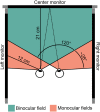Speed discrimination in the far monocular periphery: A relative advantage for interocular comparisons consistent with self-motion
- PMID: 27548085
- PMCID: PMC5015968
- DOI: 10.1167/16.10.7
Speed discrimination in the far monocular periphery: A relative advantage for interocular comparisons consistent with self-motion
Abstract
Some animals with lateral eyes (such as bees) control their navigation through the 3D world using velocity differences between the two eyes. Other animals with frontal eyes (such as primates, including humans) can perceive 3D motion based on the different velocities that a moving object projects upon the two retinae. Although one type of 3D motion perception involves a comparison between velocities from vastly different (monocular) portions of the visual field, and the other involves a comparison within overlapping (binocular) portions of the visual field, both compare velocities across the two eyes. Here we asked whether human interocular velocity comparisons, typically studied in the context of binocularly overlapping vision, operate in the far lateral (and hence, monocular) periphery and, if so, whether these comparisons were accordant with conventional interocular motion processing. We found that speed discrimination was indeed better between the two eyes' monocular visual fields, as compared to within a single eye's (monocular) visual field, but only when the velocities were consistent with commonly encountered motion. This intriguing finding suggests that mechanisms sensitive to relative motion information on opposite sides of an animal may have been retained, or at some point independently achieved, as the eyes became frontal in some animals.
Figures








Similar articles
-
Binocular Neuronal Processing of Object Motion in an Arthropod.J Neurosci. 2018 Aug 1;38(31):6933-6948. doi: 10.1523/JNEUROSCI.3641-17.2018. Epub 2018 Jul 16. J Neurosci. 2018. PMID: 30012687 Free PMC article.
-
Limits of intraocular and interocular transfer in pigeons.Behav Brain Res. 2008 Nov 3;193(1):69-78. doi: 10.1016/j.bbr.2008.04.022. Epub 2008 May 3. Behav Brain Res. 2008. PMID: 18547658
-
Speed discrimination of motion-in-depth using binocular cues.Vision Res. 1995 Apr;35(7):885-96. doi: 10.1016/0042-6989(94)00194-q. Vision Res. 1995. PMID: 7762146
-
Binocular vision and motion-in-depth.Spat Vis. 2008;21(6):531-47. doi: 10.1163/156856808786451462. Spat Vis. 2008. PMID: 19017481 Review.
-
Visual processing of the motion of an object in three dimensions for a stationary or a moving observer.Perception. 1995;24(1):87-103. doi: 10.1068/p240087. Perception. 1995. PMID: 7617421 Review.
Cited by
-
How does the human visual system compare the speeds of spatially separated objects?PLoS One. 2020 Apr 30;15(4):e0231959. doi: 10.1371/journal.pone.0231959. eCollection 2020. PLoS One. 2020. PMID: 32352993 Free PMC article.
-
Vision-based speedometer regulates human walking.iScience. 2021 Oct 30;24(12):103390. doi: 10.1016/j.isci.2021.103390. eCollection 2021 Dec 17. iScience. 2021. PMID: 34841229 Free PMC article.
References
-
- Bennett P. J,, Banks M. S. (1987). Sensitivity loss in odd-symmetric mechanisms and phase anomalies in peripheral vision. Nature, 326, 873–876. - PubMed
-
- Bex P. J,, Dakin S. C. (2005). Spatial interference among moving targets. Vision Research, 45, 1385–1398. - PubMed
-
- Bex P. J,, Dakin S. C,, Simmers A. J. (2003). The shape and size of crowding for moving targets. Vision Research, 43, 2895–2904. - PubMed
-
- Bhagavatula P. S,, Claudianos C,, Ibbotson M. R,, Srinivasan M. V. (2011). Optic flow cues guide flight in birds. Current Biology, 21, 1794–1799. - PubMed
-
- Brainard D. H. (1997). The Psychophysics Toolbox. Spatial Vision, 10, 433–436. - PubMed
MeSH terms
Grants and funding
LinkOut - more resources
Full Text Sources
Other Literature Sources

